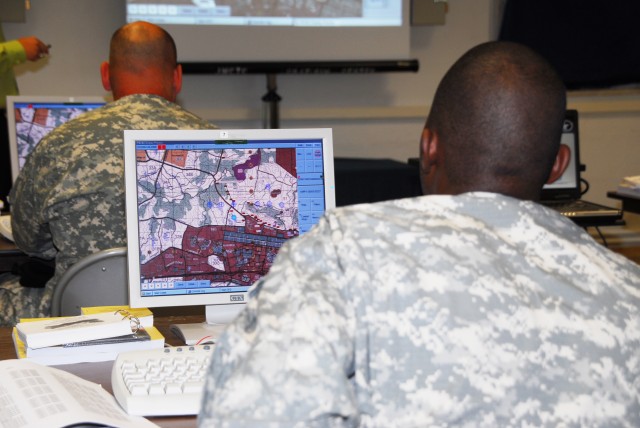
It weighs less than a helmet or a pair of combat boots, but for isolated Soldiers it could be just as critical to survival.
Through an unconventional approach - connecting an everyday cell phone to a tactical radio - Soldiers could soon have a handheld device to access information about their mission and surroundings.
"It will be under two pounds, and they'll be able to do over-the-horizon command and control and beyond-line-of-sight situational awareness," said Maj. Shane Robb, assistant product manager for Joint Battle Command - Platform (JBC-P). "For a dismount, that's really important. It also has global coverage - even up at the North Pole and South Pole, you don't have to set up channels."
By plugging into a powerful existing network, Robb and his colleagues believe their handheld combination will provide an inexpensive interim solution that could be demonstrated to Soldiers as soon as February. The concept will be demonstrated at the Association of the United States Army (AUSA) Annual Meeting and Exposition in Washington, DC the week of Oct. 25, along with other evolving capabilities in JBC-P such as TIGR integration.
"We saw a lot of potential for beyond line-of-sight capabilities to dismounted Soldiers," said Dick Sparshatt, the lead system engineer for JBC-P. "So rather than trying to bite off everything, we said we'd leave the network side alone and look to use an existing network, and just provide a small handheld-type device which is the computing platform and the user interface."
JBC-P is the second generation of Force XXI Battle Command Brigade and Below (FBCB2) - Blue Force Tracking (BFT), a digital system assigned to the Program Executive Office Command, Control and Communications - Tactical (PEO C3T). Primarily used in military vehicles, FBCB2's display screen shows blue and red icons over a geospatial imagery map. It paints a complete picture of the battlefield - including friendly forces, enemy combatants and landscape hazards - so units can synchronize operations and avoid fratricide.
While the JBC-P team is initially seeking to prove its handheld concept with commercial technology, like the Android operating system on a Nexus One phone, the Army is also pursuing prototypes for a more rugged version, Robb said. In the coming months, "user juries" of Soldiers will provide their feedback on how well the different combinations meet their needs.
But the immediate goal is to get the capability to the battlefield, fast - allowing Soldiers with handhelds to communicate over a range of 100 to 200 miles, Robb said. At the same time, the radios will serve as one-way "beacons" that show up as blue icons in the larger family of FBCB2 systems.
"It isn't the full capability that we would want, but it's an interim step until we can provide it," Robb said. He added that with the network and radios already fielded, costs would be limited to smaller items like the phones, cables, training and supporting equipment like batteries and chargers.
Also on display at AUSA will be other JBC-P upgrades, including secret data encryption, better maps and more precise location information for icons representing vehicles, aircraft and dismounted Soldiers.
This greater accuracy is made possible by the BFT 2 network, which has 10 times higher bandwidth than the current BFT 1, Sparshatt said. BFT 2 is slated to begin fielding later this year as part of the Joint Capabilities Release (JCR), the bridge to JBC-P.
Both JCR and JBC-P will also leverage Tactical Ground Reporting (TIGR), a collaborative software tool that uses a "Google Earth"-like interface, pictures and text to provide a searchable database of unit activities. Along with routes and places, TIGR is valuable for tracking people - such as local police chiefs, religious leaders or even a high-value enemy target, said John Gillette, PM FBCB2 lead for TIGR.
In JCR, users will toggle between TIGR and FBCB2; in JBC-P both applications will display on a single screen. With TIGR at their fingertips - instead of back at the base - Soldiers on patrol can adapt to changing circumstances, Gillette said.
"For the first time, TIGR will be actually on a platform-based system that can go out with vehicles," Gillette said. "In the past, Soldiers would have executed their mission based on planning they conducted on TIGR back at their operating base. Now, they can react to changes in the mission and conduct planning while in their vehicle. Leaders can plan their actions based on what is happening in the area, as well as what has happened historically. This capability increases their safety and gives them some additional resources while they're out there."
With features like drag-and-drop icons, touch-to-zoom maps and group chat, the new user interface combining JBC-P and TIGR was designed so Soldiers could learn it intuitively with little training, Robb and Gillette said.
"It was done intentionally, and it was done with user feedback," Gillette said.
Sparshatt, a former exchange officer in the British Army, has worked with FBCB2 since 1997 and said the new interface will be "more modern" than what users are accustomed to.
"You'll have a better map, and you'll be able to manipulate it - zoom in and out, move around it - much quicker," he said.
With 95,000 FBCB2 systems already fielded, PEO C3T will execute the JBC-P improvements by upgrading software on existing computers rather than immediately replacing them. That strategy is expected to yield significant cost savings, Robb said.
As they need to be refreshed, the computers will then be rotated out and replaced by models that fully meet JBC-P requirements. Eventually, commanders will be able to remove the screen from its fixed position and take it to the back seat or the hood of the vehicle, he said.

Social Sharing